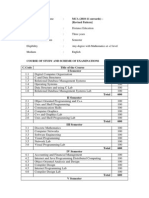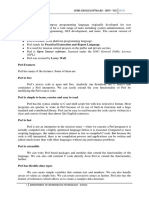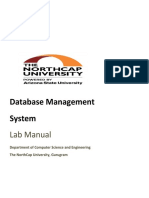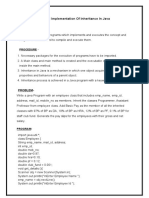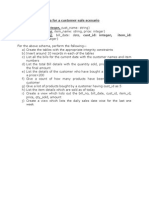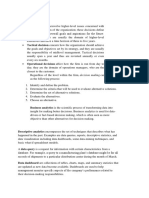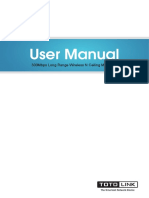0 ratings0% found this document useful (0 votes)
638 viewsDbms File
Dbms File
Uploaded by
Adam MooreThe document describes several database schemas for different scenarios including customer-sales, student library, employee payroll, and others. For each schema, it provides the table structures, sample data, and SQL queries to perform various operations like listing records, counts, and creating views. The goals are to create the tables, insert sample data, and write queries to retrieve and summarize information from the tables.
Copyright:
© All Rights Reserved
Available Formats
Download as PDF, TXT or read online from Scribd
Dbms File
Dbms File
Uploaded by
Adam Moore0 ratings0% found this document useful (0 votes)
638 views31 pagesThe document describes several database schemas for different scenarios including customer-sales, student library, employee payroll, and others. For each schema, it provides the table structures, sample data, and SQL queries to perform various operations like listing records, counts, and creating views. The goals are to create the tables, insert sample data, and write queries to retrieve and summarize information from the tables.
Original Description:
lab file
Original Title
dbms file
Copyright
© © All Rights Reserved
Available Formats
PDF, TXT or read online from Scribd
Share this document
Did you find this document useful?
Is this content inappropriate?
The document describes several database schemas for different scenarios including customer-sales, student library, employee payroll, and others. For each schema, it provides the table structures, sample data, and SQL queries to perform various operations like listing records, counts, and creating views. The goals are to create the tables, insert sample data, and write queries to retrieve and summarize information from the tables.
Copyright:
© All Rights Reserved
Available Formats
Download as PDF, TXT or read online from Scribd
Download as pdf or txt
0 ratings0% found this document useful (0 votes)
638 views31 pagesDbms File
Dbms File
Uploaded by
Adam MooreThe document describes several database schemas for different scenarios including customer-sales, student library, employee payroll, and others. For each schema, it provides the table structures, sample data, and SQL queries to perform various operations like listing records, counts, and creating views. The goals are to create the tables, insert sample data, and write queries to retrieve and summarize information from the tables.
Copyright:
© All Rights Reserved
Available Formats
Download as PDF, TXT or read online from Scribd
Download as pdf or txt
You are on page 1of 31
IILM COLLEGE OF ENGG & TECHNOLOGY
DATABASE MANAGEMENT SYSTEM LAB
FILE
(CS 402P)
CSE 4
TH
SEM
SUBMITTED TO: SUBMITTED BY:
Mr. ANKUR AGGARWAL
1
INDEX
S.no Program name Date Signature
1 Database Schema for a customer-sale scenario
Customer(Cust id : integer, cust_name: string)
Item(item_id: integer, item_name: string, price:
integer)Sale(bill_no: integer, bill_data: date, cust_id:
integer, item_id: integer, qty_sold: integer)
2 Database Schema for a Student Library scenario
Student(Stud_no : integer, Stud_name: string)
Membership(Mem_no: integer, Stud_no: integer)
Book(book_no: integer, book_name:string, author:
string)Iss_rec(iss_no:integer, iss_date: date, Mem_no:
integer, book_no: integer)
3 3. Database Schema for a Employee-pay scenario
employee(emp_id : integer, emp_name: string)
department(dept_id: integer, dept_name:string)
paydetails(emp_id : integer, dept_id: integer, basic:
integer, deductions: integer, additions: integer, DOJ:
date)payroll(emp_id : integer, pay_date: date)
4 Database Schema for a Video Library scenario
Customer(cust_no: integer,cust_name: string)
Membership(Mem_no: integer, cust_no: integer)
Cassette(cass_no:integer, cass_name:string, Language:
String) Iss_rec(iss_no: integer, iss_date: date,
mem_no: integer, cass_no: integer)
5 Database Schema for a student-Lab scenario
Student(stud_no: integer, stud_name: string, class:
string),Class(class: string, descrip: string)
Lab(mach_no: integer, Lab_no: integer, description:
String),Allotment(Stud_no: Integer, mach_no: integer,
dayof week: string)
6 Create a procedure whi ch updates the sal aries
of an employees as follows.
7 Create a procedure which updates the salaries of
an employees as follows.
2
1. Database Schema for a customer-sale scenario
Customer(Cust id : integer, cust_name: string)
Item(item_id: integer, item_name: string, price: integer)
Sale(bill_no: integer, bill_data: date, cust_id: integer, item_id: integer,
qty_sold: integer)
For the above schema, perform the following
a) Create the tables with the appropriate integrity constraints
b) Insert around 10 records in each of the tables
c) List all the bills for the current date with the customer names and item
numbers
d) List the total Bill details with the quantity sold, price of the item and the
final amount
e) List the details of the customer who have bought a product which has a
price>200
f) Give a count of how many products have been bought by each customer
g) Give a list of products bought by a customer having cust_id as 5
h) List the item details which are sold as of today
i) Create a view which lists out the bill_no, bill_date, cust_id, item_id, price,
qty_sold, amount.
3
Aim:
a) Create the tables with the appropriate integrity constraints and Insert around
10 records in each of the tables
SQL> create table customer1 (cust_id number(5) primary key, cust_name
varchar2(15));
Output: Table created.
SQL> desc customer1;
Output:
Name Null? Type
----------------------------------------- -------- ----------------
CUST_ID NOT NULL NUMBER(5)
CUST_NAME VARCHAR2(15)
b) SQL> insert into customer1 values(&cust_id,'&cust_name');
SQL> select * from customer1;
Output:
CUST_ID CUST_NAME
---------- ---------------
100 ramu
101 kamal
102 raju
103 raju sundaram
104 lawrence
SQL> create table item(item_id number(4) primary key,
item_name varchar2(15),price number(6,2));
SQL> dsec item
Output:
Name Null? Type
Cust_id NOT NULL NUMBER(4)
Item_name VARCHAR2(15)
PRICE NUMBER(6,2)
SQL>insert into item values(&item_id,&item_name,&price);
4
SQL> select * from item;
Output:
ITEM_ID ITEM_NAME PRICE
..
2334 geera 6.25
4532 corn soup 34.65
2124 lays chips 20
4531 setwet 99.99
2319 duracell 45.5
SQL>create table sale(bill_no number(5) primary key,bill_date date, cust_id
number(5) references customer(cust_id), item_id number(4) references
item(item_id),qty_sold number(4));
Output: Table Created.
SQL>dsec sale
Output:
Name Null? Type
..
BILL_NO NOT NULL NUMBER(4)
BILL_DATE DATE
CUST_ID NUMBER(5)
ITEM_ID NUMBER(4)
QTY_SOLD NUMBER(4)
SQL>insert into Sale values(&bill_no, &bill_date,
&cust_id, &item_id, &qty_sold);
SQL>select * from sale;
Output:
BILL_NO BILL_DATE CUST_ID ITEM_ID QTY_SOLD
...
1450 04-JAN-06 100 2124 2
1451 04-JAN-06 101 2319 1
1452 04-JAN-06 103 4531 2
1453 04-JAN-06 102 2334 3
1454 04-JAN-06 104 4532 3
5
c) List all the bills for the current date with the customer names and item
numbers
SQL> select c.custname, i.itemid, s.billno from customer c, item I, sale s
where c.custid=s.custid and
s.billdate=to_char(sysdate);
CUSTNAME ITEMID BILLNO
------------- --------- ---------
John 5001 332
d) List the total Bill details with the quantity sold, price of the item and the final
amount.
SQL> select i.price, s.qty,(i.price*s.qty) total from item I, sale s where
i.itemid=s.itemid;
PRICE QTY TOTAL
------- ----- --------
120 2 240
20 3 60
5 2 10
10 1 10
350 4 1400
e) List the details of the customer who have bought a product which has a
price>200
SQL> select c.custid, c.custname from customer c, sale s, item i where
i.price>200 and
c.custid=s.custid and i.itemid=s.itemid;
CUSTID CUSTNAME
--------- --------------
4 duffy
6
f) Give a count of how many products have been bought by each customer
SQL> select custid, count(itemid) from sale group by custid;
CUSTID COUNT(ITEMID)
---------- ---------------------
1 2
3 1
4 1
5 1
g) Give a list of products bought by a customer having cust_id as 5
SQL> select i.itemname from item i, sale s where s.custid=5 and i.itemid-
s.itemid;
ITEMNAME
--------------
Pens
h) List the item details which are sold as of today
SQL> select i.itemid, i.itemname from item I, sale s where
i.itemid=s.itemid
and s.billdate=to_char(sysdate);
ITEMID ITEMNAME
--------- -------------
1234 pencil
i) Create a view which lists out the bill_no, bill_date, cust_id, item_id, price,
qty_sold, amount
SQL>create view cust as (select s.billno, s.billdate, c.custid, i. iitemid,
i.price, s.qty from customer c,sale s item I where c.custid=s.custid
and i.iemid=s.itemid);
view created.
SQL>select * from cust;
BILLNO BILLDATE CUSTID ITEMID PRICE QTY
3432 12-JAN-06 3 3244 120 2
4424 20-FEB-06 1 3456 20 3
332 13-MAR-06 1 1234 5 2
2343 10-MAR-06 5 5001 10 1
1331 11-MAR-06 4 76776 350 4
7
2. Database Schema for a Student Library scenario
Student(Stud_no : integer, Stud_name: string)
Membership(Mem_no: integer, Stud_no: integer)
Book(book_no: integer, book_name:string, author: string)
Iss_rec(iss_no:integer, iss_date: date, Mem_no: integer, book_no:
integer)
For the above schema, perform the following
a) Create the tables with the appropriate integrity constraints
b) Insert around 10 records in each of the tables
c) List all the student names with their membership numbers
d) List all the issues for the current date with student and Book names
e) List the details of students who borrowed book whose author is CJDATE
f) Give a count of how many books have been bought by each student
g) Give a list of books taken by student with stud_no as 5
h) List the book details which are issued as of today
8
AIM:
Create the tables with the appropriate integrity constraints
Insert around 10 records in each of the tables
SQL>create table student(stud_no number(5) primary key,stud_name
varchar2(15));
SQL>desc student;
Name Null? Type
..
STUD_NO NOT NULL NUMBER(5)
STUD_NAME VARCAHR2(15)
Valid Test Data:
SQL>insert into student values(&stud_no,&stud_name);
SQL>select * from student;
STUD_NO STUD_NAME
....................................................................
508 HARISH
513 BALAJI
518 RAKESH
524 PAVAN
534 JOYCE
SQL>create table membership(mem_no number(5) primary key,stud_no
number(5) references student(stud_no));
SQL>dsec membership;
Name Null? Type
.
MEM_NO NOT NULL NUMBER(5)
STUD_NO NUMBER(5)
SQL>insert into membership values(&mem_no,&stud_no);
Enter value for mem_no:5440
Enter value for stud_no:510
old 1:insert into membership values(&mem_no,&stud_no)
new 1:insert into membership values(5440,510)
insert into membership values(5440,510)
*
9
Errors Observed:
ERROR at line 1:
ORA-02291:integrity constraint(HARISH.SYS_C002724)violated-primary key not
found
SQL>select * from membership;
MEM_NO STUD_NO
..
5440 513
5441 508
5442 518
5443 534
5444 524
SQL>create table book(book_no number(5) primary key,book_name
varchar2(20),author varchar2(2));
SQL>desc book;
Name Null? Type
..
BOOK_NO NOT NULL NUMBER(5)
BOOK_NAME VARCHAR2(20)
AUTHOR VARCHAR2(20)
SQL>insert into book values(&book_no,&book_name,&author);
SQL>select * from book;
BOOK_NO BOOK_NAME AUTHOR
..
9123 DBMS Rama Krishna
2342 JAVA Robett wilkins
4523 Fearless tales Alfred
8723 my ambition Harish
7821 Harry Potter JK Rowling
SQL>create table lss_rec(iss_no number primary key,iss_date date,mem_no
number(5) references membership(mem_no),book_no number(5) references
book(book_no));
10
SQL>desc iss_rec;
Name Null? Type
ISS_NO NOT NULL NUMBER
ISS_DATE DATE
MEM_NO NUMBER(5)
BOOK_NO NUMBER(5)
SQL>select * from iss_rec;
ISS_NO ISS_DATE MEM_NO BOOK_NO
43 05-JAN-06 5443 4523
81 28-DEC-05 5441 8723
22 08-DEC-05 5440 7821
53 07-JAN-06 5442 9123
35 06-JAN-06 5444 2342
c) List all the student names with their membership numbers
SQL> select s.studname, m.memno from student s, membership m where
m.studno=s.studno;
STUDNAME MEMNO
------------- --------
abhijeet 1001
arun 1002
arvind 1003
ashish 1004
ashwin 1005
d) List all the issues for the current date with student and Book names
SQL> select i.issno, s.studname, b.bookname from iss_rec I, membership m,
student s, book b
2 where i.memno=m.memno and m.studno=s.studno and
i.issdate=to_char(sysdate);
ISSNO STUDNAME BOOKNAME
------- ----------------------------------
13 arvind P&S
11
e) List the details of students who borrowed book whose author is CJDATE
SQL> select * from student where studno in(select studno from membership
where memno in
2 (select memno from iss_rec where bookno in(select bookno from book where
author=CJDATE)));
STUDNO STUDNAME
---------- -------------
505 ashwin
f) Give a count of how many books have been bought by each student
SQL> select s.studno, count(i.bookno) from student s.membership m, book b, 2
iss_rec I where s.studno=m.studno and b.bookno=i.bookno group by s.studno;
STUDNO COUNT(I.BOOKNO)
---------- -----------------------
501 5
502 5
503 5
504 5
505 5
g) Give a list of books taken by student with stud_no as 5
SQL> select bookname from book where bookno in (select bookno from iss_rec
where
2 memno in(select memno from membership where
3 studno in(select studno from student where studno=5)));
BOOKNAME
-------------
NT
h) List the book details which are issued as of today
SQL> delete from book where bookno in(select bookno from iss_rec where
issdate=to_char(sysdate));
delete from book where bookno in (select bookno from iss_rec where
issdate=to_char(sysdate))
12
3. Database Schema for a Employee-pay scenario
employee(emp_id : integer, emp_name: string)
department(dept_id: integer, dept_name:string)
paydetails(emp_id : integer, dept_id: integer, basic: integer, deductions:
integer, additions: integer, DOJ: date)
payroll(emp_id : integer, pay_date: date)
For the above schema, perform the following
a) Create the tables with the appropriate integrity constraints
b) Insert around 10 records in each of the tables
c) List the employee details department wise
d) List all the employee names who joined after particular date
e) List the details of employees whose basic salary is between 10,000 and
20,000
f) Give a count of how many employees are working in each department
g) Give a names of the employees whose netsalary>10,000
h) List the details for an employee_id=5
13
AIM: Create the tables with the appropriate integrity constraints
Insert around 10 records in each of the tables
Create table employee(emp_id number(5) primary key,emp_name
varchar2(25));
SQL>desc employee;
Name Null? Type
..
EMP_ID NOT NULL NUMBER(5)
EMP_NAME VARCHAR2(25)
Valid Test Data:
SQL>insert into employee values(&emp_id,&emp_name);
SQL>select * from employee;
EMP_ID EMP_NAME
.
10 Robert
21 Coulthard
30 Fernando Alonso
39 Kartikeyan
87 Kimmi
SQL>create table department(dept_id number(5) primary key,dept_name
varchar2(20));
SQL>desc department;
Name Null? Type
..
DEPT_ID NOT NULL NUMBER(5)
DEPT_NAME VARCHAR2(20)
SQL>insert into department values(&dept_id,&dept_name);
SQL>select * from department;
DEPT_ID DEPT_NAME
..
100 sales
101 accounts
102 administration
103 production
104 supervisor
14
SQL>create table paydetails(emp_id number(5) references
employee(emp_id),dept_id number(5) reerences department(dept_id),basic
number(7,2),deductions number(5,2),additions number(5,2),doj date);
SQL>desc paydetails;
Name Null? Type
..
EMP_ID NUMBER(5)
DEPT_ID NUMBER(5)
BASIC NUMBER(7,2)
DEDUCTIONS NUMBER(5,2)
ADDITIONS NUMBER(5,2)
DOJ DATE
Different Data Sets:
SQL>insert into paydeatils values(&emp_id,&dept_id,
&basic,&deductions,&additions,&doj);
SQL>select * from paydeatils;
EMP_ID DEPT_ID BASIC DEDUCTIONS ADDITIONS DOJ
..
10 101 25023.12 43.09 71.23 08-JAN-93
21 100 10500.29 23.98 40.9 01-JAN-06
30 102 6500.5 30.54 15 06-JUL-97
39 103 9700.45 32.78 65.09 08-AUG-03
87 104 15000 97.66 154.8 24-SEP-04
SQL>create table payroll(emp_id number(5)references
employee(emp_id),pay_date date);
SQL>desc payroll;
Name Null? Type
..
EMP_ID NUMBER(5)
PAY_DATE DATE
SQL>insert into payroll values(&emp_id,&date);
SQL>select * from payroll;
15
EMP_ID PAY_DATE
.
10 31-JAN-06
21 03-FEB-06
30 15-JAN-06
39 27-JAN-06
87 04-FEB-06
c) List the employee details department wise
SQL>select empid,deptid from paydet;
EMPID DEPTID
401 500
402 200
403 600
404 400
405 1200
d) List all the employee names who joined after particular date
SQL>select e,empname from employee e,paydet p where e.empid=p.empid and
p.doj>=05-mar-06;
EMPNAME
AVINASH
NITIN
PHALGUN
e) List the details of employees whose basic salary is between 10,000 and
20,000
sqL> Select empid,empname from employee where salary between 10000 and
20000;
EMPID EMPNAME
.
402 AKHILA
403 aaaaaaaa
EMPID EMPNAME
.
AKHILA
16
f) Give a count of how many employees are working in each department
SQL>select count(empid),deptid from paydet group by deptid;
COUNT (EMPID) DEPTID
1 200
1 400
1 500
1 600
1 1200
g) Give a names of the employees whose netsalary>10,000
SQL> select empname from employee where empid in(select empid from paydet
where basic-deduction>10000);
EMPNAME
AVINASH
AKHILA
HARISH
NITIN
PHALGUN
h) List the details for an employee_id=5
SQL> select * from employee where empid=5;
EMPID EMPNAME
------------------------------------------
5 Coulthard
17
4. Database Schema for a Video Library scenario
Customer(cust_no: integer,cust_name: string)
Membership(Mem_no: integer, cust_no: integer)
Cassette(cass_no:integer, cass_name:string, Language: String)
Iss_rec(iss_no: integer, iss_date: date, mem_no: integer, cass_no:
integer)
For the above schema, perform the following
a) Create the tables with the appropriate integrity constraints
b) Insert around 10 records in each of the tables
c) List all the customer names with their membership numbers
d) List all the issues for the current date with the customer names and
cassette names
18
AIM: Create the tables with the appropriate integrity constraints
Insert around 10 records in each of the tables
SQL>create table customer(cust_no number(5) primary key,cust_name
varchar2(20));
SQL>desc customer;
Name Null? Type
..
CUST_NO NOT NULL NUMBER(5)
CUST_NAME VARCHAR2(20)
Valid Test Data:
SQL>insert into customer values(&cust_no,&cust_name);
SQL>select * from customer;
CUST_NO CUST_NAME
.
50 scott
51 pandey
52 varshney
53 naidu
54 bhimbra
SQL>create table membership(mem_no number(5) primary key,cust_no
number(5) references customer(cust_no));
SQL>dsec membership;
Name Null? Type
...
MEM_NO NOT NULL NUMBER(5)
CUST_NO NUMBER(5)
SQL>insert into memship values(&mem_no,&cust_no);
SQL>select * from memship;
19
MEM_NO CUST_NO
920 50
981 51
897 52
820 53
928 54
SQL>create table cassette(cass_no number(5) primary key,
Cass_name varchar2(15),language varchar2(15));
SQL>desc cassette;
Name Null? Type
..
CASS_NO NOT NULL NUMBER(5)
CASS_NAME VARCHAR2(15)
LANGUAGE VARCHAR2(15)
SQL>insert into cassette values(&cass_no,&cass_name,&language);
SQL>select * from cassette;
CASS_NO CASS_NAME LANGUAGE
1 tagore telugu
2 the lion king English
3 anniyan tamil
4 indra telugu
5 lord of rings English
SQL>create table issu_rec(iss_no number(5) primary key,iss_date date,mem_no
number(5)references memship(mem_no),cass_no number(5) references
cassette(cass_no));
SQL>desc issu_rec;
Name Null? Type
...
ISS_NO NOT NULL NUMBER(5)
ISS_DATE DATE
MEM_NO NUMBER(5)
CASS_NO NUMBER(5)
20
SQL>select * from issu_rec;
ISS_NO ISS_DATE MEM_NO CASS_NO
22 07-JAN-06 920 1
23 10-JAN-00 981 2
26 10-JAN-06 897 5
3 01-JAN-06 820 4
34 31-DEC-05 928 3
c) List all the customer names with their membership numbers
SQL>select c.custname,m.memno from customer1 c,membership1 m where
c.custno=m.custno;
CUSTNAME MEMNO
.. ..
NIKHIL 51
VIVEK 52
SHRAVAN 58
VAMSI 57
SHIVA 56
d) List all the issues for the current date with the customer names and cassette
names
SQL>select i.issno,c.custname,cc.cassettename from customer1
c,membership1 m,cassette cc,issrec1 I where i.issdate=to_char(sysdate)
and c.custno=m.custno and i.cassno=cc.cassno and i.memno=m.memno;
OutPut:
no rows selected.
21
5.Database Schema for a student-Lab scenario
Student(stud_no: integer, stud_name: string, class: string)
Class(class: string, descrip: string)
Lab(mach_no: integer, Lab_no: integer, description: String)
Allotment(Stud_no: Integer, mach_no: integer, dayof week: string)
For the above schema, perform the following
a) Create the tables with the appropriate integrity constraints
b) Insert around 10 records in each of the tables
c) List all the machine allotments with the student names, lab and machine
numbers
d) List the total number of lab allotments day wise
e) Give a count of how many machines have been allocated to the CSIT
class
f) Give a machine allotment etails of the stud_no 5 with his personal and
class details
g) Count for how many machines have been allocatedin Lab_no 1 for the
day of the week as Monday
h) How many students class wise have allocated machines in the labs
22
AIM: Create the tables with the appropriate integrity constraints
Insert around 10 records in each of the tables
SQL>create table stu(stud_no number(5) primary key,stud_nam
varchar2(20),class varchar2(20));
SQL> desc stu;
Name null? Type
STUD_NO NOT NULL NUMBER(5)
STUD_NAM VARCHAR2(20)
CLASS VARCHAR2(20)
Valid Data Sets:
SQL> insert into stu values(&stud_no,&stud_nam,&class);
SQL> select * from stu;
STUD_NO STUD_NAM CLASS
39 LEON CSE
34 VIKAS CSIT
18 MATHEW ECE
8 HANSEN MECH
24 ALEXIS EEE
SQL> Create table class (class varchar2(20), descript varchar2(10));
SQL> Describe class;
Name null type
CLASS VARCHAR2(10)
DESCRIPT VARCHAR2(20)
SQL> create table lab(match_no number(5), lab_no number(5), description
varchar2(20));
SQL> desc lab;
Name null type
MACH_NO NOT NULL NUMBER(5)
LAB_NO NUMBER(5)
DESCRIPTION VARCHAR2(20)
23
SQL> insert into lab values(&mach_no,&lab_no,&description);
SQL> select * from lab;
MATCH_NO LAB_NO DESCRIPTION
--------------- --------- --------------------
23 7 physics
78 2 chemistry
87 1 edc
12 10 cds
8 3 java lab
SQL> create table allotment(stud_no number(5) references stu(stud_no),
match_no number(5) references lab(mach_no),
Doweek varchar2(20));
SQL> desc allotment;
Name Null? Type
-------------- ------- ------------------------
STUD_NO NUMBER(5)
MACH_NO NUMBER(5)
DOWEEK VARCHAR2(20)
SQL>select * from allotment;
STUD_NO MACH_NO DOWEEK
------------- -- ------------ ------------
39 23 sat
34 87 mon
18 78 tue
8 12 wed
24 12 thu
24
c) List all the machine allotments with the student names, lab and machine
numbers
SQL>select s.studname,l.machno from student1 s,lab l,allotment a where
a.machno=l.machno and a.studno=s.studno;
STUDNAME MACHNO
..
ABHIJEET 1
KALYAN 22
ASHWIN 3
ARKA 4
ARVIND 5
d) List the total number of lab allotments day wise
SQL>select l.machno,l.descrip,a.day from lab l,allotment a where
a.machno=l.machno;
MACHNO DESCRIP DAY
1 UNIX MONDAY
22 UNIX TUESDAY
3 XP WEDNESDAY
4 WINDOWS THRUSDAY
5 ME FRIDAY
e) Give a count of how many machines have been allocated to the CSIT class
SQL>select count(machno)from allotment where studno in(select studno
from student1 where class=CSIT);
COUNT (MACHNO)
..
1
6
25
f) Give a machine allotment etails of the stud_no 5 with his personal and class
details
SQL>select a.studno,a.machno,s.studname,s.class from allotment a,student1
s where a.studno=s.studno and a.studno=503;
STUDNO MACHNO STUDNAME CLASS
503 5 ARVIND CSE
g) Count for how many machines have been allocatedin Lab_no 1 for the day
of the week as Monday
h) How many students class wise have allocated machines in the labs
SQL>select count(studno) allocated students in the labs,class from
student1 where studno in(select studno from allotment) group by class;
allocated students in the lab CLASS
2 CSE
1 ECE
1 EEE
1 IT
26
6) Create a Cursor which update the salaries of an
Employee as follows.
1. if sal<1000then update the salary to 1500.
2. if sal>=1000 and <2000 then update the salary to 2500.
3. if sal>=2000 and <=3000 then update the salary to 4000.
And also count the no.of records have been updated.*/
Code:
Declare
Cursor my_cur is select empno,sal from emp;
Xno emp.empno%type;
Xsal emp.sal%type;
C number;
Begin
Open my_cur;
C:=0;
Loop
Fetch my_cur into xno,xsal;
If(xsal<1000) then
Update emp set sal=3000 where empno=xno;
C:=c+1;
Else if(xsal>=2000) and xsa<3000) then
Update emp set sal=4000 where empno=xno;
C:=c+1;
End if;
End if;
Exit when my_cur%NOTFOUND ;
End loop;
Close my_cur;
Dbma_output.put_line(c||records have been successfully updated);
End;
Sql>@a.sql;
records have been successfully updated
pl/sql procedure successfully completed.
Valid Test Data
Before executing the cursor, the records in emp table as follows
Sql>select * from emp;
27
OUTPUT:
EMPNO ENAME JOB MGR HIREDATE SAL COMMD EPTNO
-----------------------------------------------------------------
7369 SMITH CLERK 7902 17-DEC-80 2000 20
7499 ALLEN SALESMAN 7698 20-FEB-81 1600 300 30
7521 WARD SALESMAN 7698 22-FEB-81 1250 500 30
EMPNO ENAME JOB MGR HIREDATE SAL COMM DEPTNO
-------- ---------- --------- ---------- --------- ---------- ----------------------
7566 JONES MANAGER 7839 02-APR-81 2975 20
7654 MARTIN SALESMAN 7698 28-SEP-81 1250 30
7698 BLAKE MANAGER 7839 01-MAY-81 2850 30
.
14 rows selected.
28
7) Create a procedure which updates the salaries of
an employees as follows.
1.if sal<1000 then update the salry to 1500.
2.if sal>=1000 and <=2400 then update the salary to 2500.*/
Create or replace procedure myproc as
Cursor my_cur is select empno,sal from emp;
Xno emp.empno%type;
Xsal emp.sal%type;
C number;
Begin
Open my_cur;
C:=0;
Loop
Fetch my_cur into xno,xsal;
If(xsal<1000) then
Update emp set sal=1500 where empno=xno;
C:=c+1;
Else
Is(xsal>=1000 and xsal<=2400) then
Update emp set sal=2500 where empno=xno;
C:=c+1;
End if;
End if;
Exit when my_cur%NOTFOUND;
End loop;
Close my_cur;
Dbms_output.put_line(c||records have been successfully updated);
End;
/
Valid Test Data:
Procedure created.
Sql>exec myproc;
29
OUTPUT:
Records have been successfully completed.
/* create function which add two given numbers. (Simple programs)
*/
Create or replace function add_fun(a number,b number) return
Number as
C number;
Begin
C:=a+b;
Return c;
End;
/
Function created.
/*add_fun specification*/
Declare
Result number;
Begin
Result:=add_fun(10,20);
Dbms_output.put_line(the sum of 10 and 20 is||result);
End;
Sql>/
The sum of 10 and 20 is 30
Pl/sql procedure successfully completed.
/*create a function which count total no.of employees having salary
less than 6000.*/
/*function body*/
Create or replace function count_emp(esal number)return number as
Cursor vin_cur as Select empno,sal from emp;
Xno emp.empno%type;
Xsal emp.sal%type;
C number;
Begin
Open vin_cur;
C:=0;
loop
fetch vin_cur into xno,xsal;
if(xsal<esal) then
c:=c+1;
end if;
exit when vin_cur%notfound;
end loop;
close vin_cur;
return c;
30
end;
/
Function created.
/*function specification*/
Declare
Ne number;
Xsal number;
Begin
Ne:=count_emp(xsal);
Dbms_output.put_line(xsal);
Dbma_output.put_line(there are ||ne||;employees);
End;
/
OUTPUT
There are 8 employees.
You might also like
- Client Server Architecture A Complete Guide - 2020 EditionFrom EverandClient Server Architecture A Complete Guide - 2020 EditionNo ratings yet
- Software EngineeringDocument3 pagesSoftware EngineeringImtiyaz BashaNo ratings yet
- Dbms RiddhiDocument64 pagesDbms RiddhiHorror & Slasher Movies100% (1)
- Practical 1: Develop and Demonstrate The Usage of Inline, Internal and External Style Sheet Using CSS. SolutionDocument4 pagesPractical 1: Develop and Demonstrate The Usage of Inline, Internal and External Style Sheet Using CSS. SolutionDenceyNo ratings yet
- Web Technology LabFileDocument28 pagesWeb Technology LabFileRaj Nish100% (1)
- ERP Unit 4Document44 pagesERP Unit 4Sudhakar BolledduNo ratings yet
- R - Programming Slip SolutionDocument11 pagesR - Programming Slip SolutionMohit TaurNo ratings yet
- Syllabus of MCA - Bridge Course (Mangt) (2020patt.) 2020 - 2022 - 13.05.2021Document13 pagesSyllabus of MCA - Bridge Course (Mangt) (2020patt.) 2020 - 2022 - 13.05.2021Dhananjay LondheNo ratings yet
- SC&RP - Unit 5Document36 pagesSC&RP - Unit 5ProfessorNo ratings yet
- DBMS LAB Manual Final22Document74 pagesDBMS LAB Manual Final22naveed ahmed0% (1)
- Synopsis of Mailing SystemDocument29 pagesSynopsis of Mailing SystemFreeProjectz.com0% (1)
- Relational Data Base Management SystemDocument3 pagesRelational Data Base Management SystemNitesh BhuraNo ratings yet
- F PDFDocument86 pagesF PDFdev dev100% (1)
- Mca Alagappa UniversityDocument27 pagesMca Alagappa UniversityTirthajit SinhaNo ratings yet
- Mad 3.4Document5 pagesMad 3.4Aman SinghNo ratings yet
- Nishant Web TechDocument40 pagesNishant Web TechNishant MishraNo ratings yet
- ASP.NETDocument4 pagesASP.NETRizwan Ahmed100% (1)
- RDBMS LAB ManualDocument29 pagesRDBMS LAB ManualKetanPatelNo ratings yet
- Gudlavalleru Engineering College Gudlavalleru Department of Computer Science and Engineering DBMS Lab Manual For Students II B.Tech II Sem R-10Document48 pagesGudlavalleru Engineering College Gudlavalleru Department of Computer Science and Engineering DBMS Lab Manual For Students II B.Tech II Sem R-10Akshay ChavanNo ratings yet
- OSAssignment K1508Document15 pagesOSAssignment K1508Happy0% (1)
- Oss Unit-8 PDFDocument24 pagesOss Unit-8 PDFTarun Kumar100% (1)
- CSE II-II SEM (DBMS Lab Manual) PDFDocument124 pagesCSE II-II SEM (DBMS Lab Manual) PDFanon_490696072100% (1)
- DBMS Lab Manual-CseDocument45 pagesDBMS Lab Manual-Cse20BECSE028 KIRUBANANDHAM KNo ratings yet
- COMPUTER PRACTICAL FILE (Class 12)Document49 pagesCOMPUTER PRACTICAL FILE (Class 12)ishika guptaNo ratings yet
- Java Project ReportDocument32 pagesJava Project ReportDeepanshu AryaNo ratings yet
- Unit 7Document46 pagesUnit 7zoya fathimaNo ratings yet
- PHP (Hypertext Pre-Processor)Document10 pagesPHP (Hypertext Pre-Processor)Khagesh JoshNo ratings yet
- Data Structures With C NotesDocument118 pagesData Structures With C NotesDheeraj NambiarNo ratings yet
- Project Report PDFDocument44 pagesProject Report PDFAkshay MaherNo ratings yet
- Implementation of XML, DTD and XSLTDocument3 pagesImplementation of XML, DTD and XSLTAmit ModiNo ratings yet
- KM Notes Unit-1Document20 pagesKM Notes Unit-1Shailendra Singh100% (1)
- NETWORKING BCA WBUT 5th SEM NOTESDocument135 pagesNETWORKING BCA WBUT 5th SEM NOTESapi-1958925986% (22)
- Information System Management Lab FileDocument32 pagesInformation System Management Lab FileBhavya UdiniaNo ratings yet
- Appu ReoprtDocument23 pagesAppu ReoprtApoorva AppuNo ratings yet
- UNIT2Document51 pagesUNIT2orangesareamazing46No ratings yet
- (CSE3083) Lab Practical Assignment 2Document8 pages(CSE3083) Lab Practical Assignment 2Arun Kumar Singh0% (1)
- Final DBMS ManualDocument92 pagesFinal DBMS ManualThe ultimate MathsNo ratings yet
- Pear DBDocument29 pagesPear DBnandini jadhavNo ratings yet
- EX No: 6 Implementation of Inheritance in Java: ProcedureDocument4 pagesEX No: 6 Implementation of Inheritance in Java: Procedure20TUIT045 LAKSHMI PRIYA DHARSHINI.SNo ratings yet
- Nursery Plant Management SystemDocument30 pagesNursery Plant Management SystemKapil SidhpuriaNo ratings yet
- Agriculture Management System-3Document22 pagesAgriculture Management System-3PrasadNo ratings yet
- Certificate: Kamala Education Society'sDocument25 pagesCertificate: Kamala Education Society'sspider manNo ratings yet
- Technical Docs of NETFLIX MOVIES AND TV SHOWS CLUSTERINGDocument12 pagesTechnical Docs of NETFLIX MOVIES AND TV SHOWS CLUSTERINGRANJIT BISWAL (Ranjit)No ratings yet
- Codeigniter Interview Questions and Answers For Freshers and Experienced PDFDocument11 pagesCodeigniter Interview Questions and Answers For Freshers and Experienced PDFRagin Mariya Joseph0% (2)
- Dbms Lab Manual RGPVDocument38 pagesDbms Lab Manual RGPVcsedepartmentsistecrNo ratings yet
- LP-III - Mini Project Report (ML)Document15 pagesLP-III - Mini Project Report (ML)nateshkhadse.sits.compNo ratings yet
- Ip Lab QuestionsDocument3 pagesIp Lab QuestionsJetlin C PNo ratings yet
- HTMLDocument8 pagesHTMLUmesh VermaNo ratings yet
- Practical File of Computer Application - Ii: Bba 4 SemesterDocument44 pagesPractical File of Computer Application - Ii: Bba 4 Semesteraashish guptaNo ratings yet
- DBMS LaboratoryDocument21 pagesDBMS LaboratoryVijeth NarayanNo ratings yet
- OOPS Concepts in PHPDocument40 pagesOOPS Concepts in PHPSanjog Srivastava100% (2)
- Unit 3 Big Data MCQ AKTU: Royal Brinkman GartenbaubedarfDocument17 pagesUnit 3 Big Data MCQ AKTU: Royal Brinkman GartenbaubedarfAhmed MohamedNo ratings yet
- Introduction To HTML - NotesDocument4 pagesIntroduction To HTML - NotesAmit RathodNo ratings yet
- COCOMO II A Parametric Productivity Model: Software Project Management (KOE-068)Document2 pagesCOCOMO II A Parametric Productivity Model: Software Project Management (KOE-068)pemom29928No ratings yet
- RDBMS Lab Manual Mechanical RGPVDocument14 pagesRDBMS Lab Manual Mechanical RGPVRoshan Ekka0% (1)
- Session 13 AO Memory Bounded Heuristic Search Heuristic FunctionsDocument22 pagesSession 13 AO Memory Bounded Heuristic Search Heuristic FunctionsMarkapuri Santhoash kumarNo ratings yet
- Mca Project Guidelines CompleteDocument13 pagesMca Project Guidelines CompleteHeemanshu SarkarNo ratings yet
- Network Management System A Complete Guide - 2020 EditionFrom EverandNetwork Management System A Complete Guide - 2020 EditionRating: 5 out of 5 stars5/5 (1)
- Customer Sales - SQL QueriesDocument6 pagesCustomer Sales - SQL QueriesDr. MNV Kiranbabu0% (1)
- Lab4-PL - SQL 000Document9 pagesLab4-PL - SQL 000sastrylanka_19800% (1)
- CodaDocument15 pagesCodaShashi KartikyaNo ratings yet
- Beatrice Kung'uDocument16 pagesBeatrice Kung'uBeatrice WanjuguNo ratings yet
- Reviewer Business AnalyticsDocument11 pagesReviewer Business AnalyticsDaniel JadeNo ratings yet
- Algorithm of Insertion of An Element at Desire Position Into An ArrayDocument67 pagesAlgorithm of Insertion of An Element at Desire Position Into An ArrayAmit SinghNo ratings yet
- ct1 Previous Year PaperDocument2 pagesct1 Previous Year PaperM. VareshNo ratings yet
- Lynda AutoCAD Facilities Management Tutorial SeriesDocument2 pagesLynda AutoCAD Facilities Management Tutorial SerieslaikienfuiNo ratings yet
- Nursing Informatics Assignment Website AnalysisDocument6 pagesNursing Informatics Assignment Website AnalysisJopaii TanakaNo ratings yet
- User Manual: 300Mbps Long Range Wireless N Ceiling Mount APDocument24 pagesUser Manual: 300Mbps Long Range Wireless N Ceiling Mount APbatuxpNo ratings yet
- JNTUA - R20 Regulations - B.Tech. - SWAYAM Courses - III B.Tech. II SemesterDocument3 pagesJNTUA - R20 Regulations - B.Tech. - SWAYAM Courses - III B.Tech. II SemesterHema TharunNo ratings yet
- What Is Internet NightDocument12 pagesWhat Is Internet NighttayituNo ratings yet
- Market Analysis Virtual and Mixed RealityDocument4 pagesMarket Analysis Virtual and Mixed RealityFELIPENo ratings yet
- Survey Project Report of "DIFFERENT BRANDED LAPTOP PREFEERED BY WORKING EXECUTIVE"Document34 pagesSurvey Project Report of "DIFFERENT BRANDED LAPTOP PREFEERED BY WORKING EXECUTIVE"vikash_singh0894% (16)
- UntitledDocument8 pagesUntitledsunitatybscNo ratings yet
- EE521: Advanced Communications EE521: Advanced CommunicationsDocument25 pagesEE521: Advanced Communications EE521: Advanced CommunicationsTa HienNo ratings yet
- Infosys Placement PaperDocument84 pagesInfosys Placement PaperSup RajaNo ratings yet
- Python For Data AnalysisDocument39 pagesPython For Data Analysiswvargas92667% (3)
- Pdfdocs 4 - Advanced User GuideDocument86 pagesPdfdocs 4 - Advanced User GuideTest 001No ratings yet
- QWDQWDDocument6 pagesQWDQWDSalman AslamNo ratings yet
- Improved Three-Phase Power-Flow Methods Using Sequence Components - MA Akher - KM Nor - AHA RashidDocument13 pagesImproved Three-Phase Power-Flow Methods Using Sequence Components - MA Akher - KM Nor - AHA RashidIndra AditamaNo ratings yet
- Java AutomotiveDocument6 pagesJava AutomotiveZahirul WayneNo ratings yet
- Ideal Flow Traffic Analysis: A Case Study On A Campus Road NetworkDocument12 pagesIdeal Flow Traffic Analysis: A Case Study On A Campus Road NetworkDiana SeguiNo ratings yet
- EslqDocument22 pagesEslqecejmrNo ratings yet
- Debugging With GDB - Xcode Iphone Adventures: Thread Apply BacktraceDocument4 pagesDebugging With GDB - Xcode Iphone Adventures: Thread Apply BacktraceJessy OwenNo ratings yet
- 4 ADocument5 pages4 ADaljot Singh KangNo ratings yet
- Technical Description of The Mt940 Statement Format For Business 24Document8 pagesTechnical Description of The Mt940 Statement Format For Business 24tracefalcon007No ratings yet
- Angular2 SuccinctlyDocument14 pagesAngular2 SuccinctlyddoruNo ratings yet
- Data Mining - Other ClassifiersDocument7 pagesData Mining - Other ClassifiersRaj EndranNo ratings yet
- Winaudit AdministradorDocument384 pagesWinaudit AdministradorNATALIANo ratings yet
- EE428 Industrail Process Control - OutlineDocument3 pagesEE428 Industrail Process Control - OutlineabdurrehmanNo ratings yet













